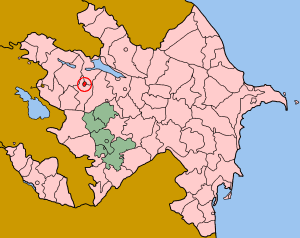Ganja, Azerbaijan
Contributors to Wikimedia projects
 Article Images
Article Images
- For the city in Tajikistan, see Panj.
| Municipality: | Ganja |
| Area: | 1000 km² |
| Altitude: | 408 m |
| Population: | 500,000 census 2006 |
| Postal Code: | AZ1000 |
| Area code: | 016 |
| Municipality code: | GA |
| Latitude: | 40° 40' 58 N |
| Longitude: | 46° 21' 38 E |
| Mayor: | Eldar Azizov |
Ganja IPA: [gæn'ʤæ] (Azerbaijani: Gəncə, Persian: گنجه/Ganj-ja) is Azerbaijan's second largest city.
The city, first mentioned in Armenian early medieval sources, was most likely founded in the 5th century AD by Armenians; it is is known among them as Gandzak (Գանձակ).[1] To explain the etymology of "Ganja", people refer either to the Armenian word gandz (գանձ: treasure, riches), Persian word ganj (گنج: "treasure, treasury", of Persian origin), or to the genç ("young"), which is of either Kurdish or Turkic origin.
Historically an important city of Iran (Persia), Ganja is also the birthplace of the famous classical Persian poet Nizami. People of Ganja experienced cultural decline after an earthquake in 1139 and the Mongol invasion in 1231. The city was revived after the Safavids came to power. For a short period of time, Ganja was renamed Abbasabad by Shah Abbas I.[2] In 1747, Ganja became the capital of the independent Ganja Khanate. In October 1813, the Gulistan Treaty transferred the city to the Russians after Persia's defeat in the Persia-Russia wars. It was renamed Elizavetpol after the wife of Alexander I of Russia, Elizabeth.
In 1918, Ganja became the temporary capital of the Azerbaijan Democratic Republic (which renamed it Ganja again), until Baku was recaptured from the British backed Centro Caspian Dictatorship. In 1920, the Red Army conquered Azerbaijan and in 1935 Joseph Stalin renamed the city Kirovabad after Sergei Kirov. In 1991, Azerbaijan became independent, and the ancient name of the city was re-established.
Today Ganja is the second largest city in Azerbaijan. [citation needed] The population is about 500,000. [citation needed] It has an airport, and is home to the Nizami Mausoleum, built in 1991.
Education
Ganja is home to four major institutes of post-secondary education.
Famous People
Ganja is known for its famous people:
- Kirakos Gandzaketsi - Կիրակոս Գանձակեցի, 1201-1271, author of the History of Armenia
- Mkhitar Gosh - Մխիթար Գոշ, c. 1130–1213, author of Armenia's Code of Laws
- Grigor Paron-Ter - Գրիգոր Պարոն Տեր, 1560-1645, Armenian Patriarch of Jerusalem
- Mahsati Ganjavi
- Nizami Ganjavi
- Javad Khan
- Mirza Shafi Vazeh
- Mirza Topchubashov
- Israfil Mammadov
- Fikrat Amirov
- Nigar Rafibeyli
Pictures of Ganja
-
The Nizami Ganjavi Monument in Ganja
-
Ganja archeological museum
-
Ganja city hall
-
Ganja State Academy of Sciences
-
One of the many statues of Nizami Ganjavi
-
Ganja downtown
-
A street in Ganja
-
Shakh Abbas Mosque
-
Decorated houses of Ganja
-
Nizami Ganjavi Main Statue in Ganja
References
- ^ Robert H. Hewsen. Armenia: A Historical Atlas. Un. of Chicago Press. 2002
- ^ Seyyaf Sednik oqli Pashayev. "The Monuments of Ganja Khanate of the Period form 1606 - 1804". Retrieved 2007-02-16.
